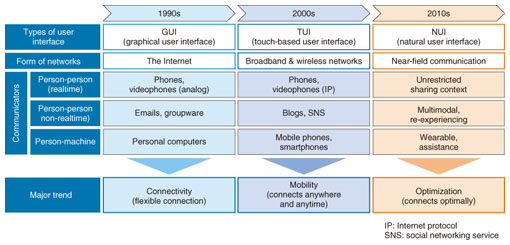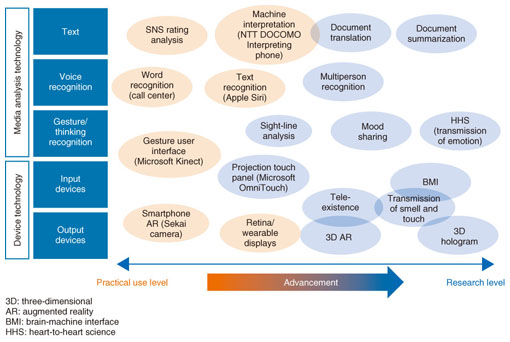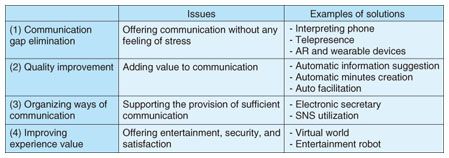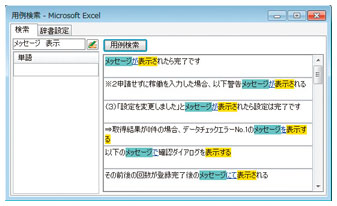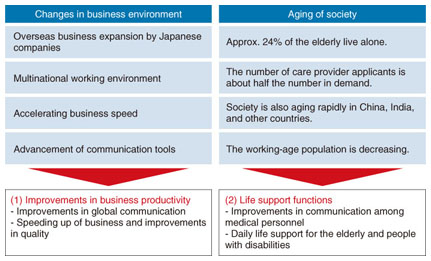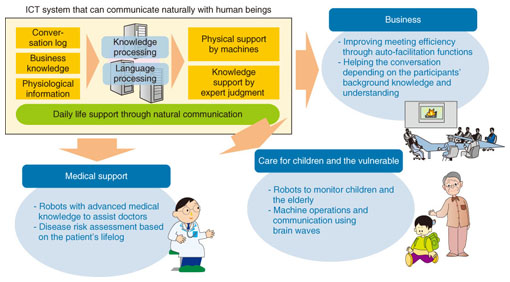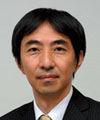 |
|||
|
|
|||
|
Feature Articles: ICT Infrastructure Technology Underlying System Innovation Vol. 10, No. 11, pp. 57–62, Nov. 2012. https://doi.org/10.53829/ntr201211fa11 Technology Development for Communication AdvancementAbstractThis article introduces NTT DATA's research and development activities for advancing communications among people and between people and machines and mentions future prospects. High-quality communication is now receiving attention as a key element for improving corporate productivity and creating a better society. 1. IntroductionCorporations and public bodies hope to reinforce their competence in the domestic and international markets by improving productivity. One way to achieve this is to strengthen organizational bonds and improve productivity through advances in communication. Efficient realtime communication among people is important. Furthermore, smoother person-to-machine communication and person-to-person communication achieved through machines is essential in the current communication environment, where information and communications technology (ICT) systems are becoming a prerequisite. At the same time, the utilization of unstructured data, such as documents, emails, and other textual information managed within systems, is increasingly expected to contribute to improvements in productivity. The means to bridge the communication gap in a diverse world is also awaited. This includes a way to overcome language barriers and support handicapped people to enable them to become more independent. Human-machine interfaces keep changing to suit the devices that are common at a particular time, and the interfaces have a great impact on the usability of communications. Communications technology is now a component of the ICT infrastructure. 2. History of communications technologiesTo enable a clearer understanding of the technological trend of communications technologies, a brief history of them is shown in Fig. 1.
In the 1990s, the dominant means of communication shifted from the telephone to email as the Internet became commonplace. It was the decade when person-to-person communication was linked via ICT systems. During the first decade of this century, the form of communication developed into communication available at anytime and anywhere as a result of the explosive spread of mobile communication devices such as cell phones and wireless broadband. Furthermore, as smartphones became popular, people became accustomed to touch-based user interfaces. In the 2010s, we assume that optimum communication, in which the means of communication is optimized according to the users' situations, will become the norm. The critical technologies for optimum communication are media analysis technology that utilizes linguistic and non-linguistic data and device technology that improves the human-machine interface. These technologies are now being vigorously studied from the research level to the practical level (Fig. 2).
Recent examples of advanced communication applications that utilize the rapidly spreading smartphones are NTT DOCOMO's Shabette Concier (talking concierge) and Apple's Siri. More new services that use advanced media processing and devices are expected to follow. 3. Aims of communication advancementWe believe that communication advancement can resolve the issues in the following four categories: eliminating the communication gap, improving communication quality, optimizing multiplexed communication, and improving the experience value (Table 1).
As the first step to tackle these issues, NTT DATA is currently working to develop application software to eliminate the communication gap. We aim to raise the current, insufficient, level of ICT-based communication to the level at which people can communicate without stress. Expectations for linguistic support services to overcome the language barrier are rising to cope with the rapid global expansion of businesses and social activities. We aim to develop application software that will help users understand foreign languages and create documents in multiple languages. Our ongoing projects include developing machine translation software optimized for different businesses and users and document creation software. 4. Examples of NTT DATA projects4.1 Japanese document creation support tool for software developmentWith computer systems being increasingly developed offshore, such as in China, the proportion of development-related documents in Japanese created by non-Japanese speakers is also rising. However, this causes various problems such as a longer development period and larger number of grammatical and expressional errors in documents owing to the inadequate Japanese language skills of non-Japanese document writers. Countermeasures to address this linguistic gap are required. NTT DATA is currently developing a foreign language document creation tool that can take account of error tendencies caused by differences in the linguistic characteristics of the language used in the document and the mother language of the document writers. This tool is designed particularly for Chinese people who create documents in Japanese. It has an example text search function and a Japanese checker function. (1) Example text search function The example text search function identifies grammatically correct text in a collection of previously created documents as a reference for the document writers to help them create correct sentences. One of the features of this function is that it displays examples of text containing the most frequent items first, such as Japanese particles and verb conjugation. It also displays simple sentences that are preferred in design documents and business letters near the top of the search results. This ensures that the most suitable examples are shown to the users. An output example is shown in Fig. 3. This example shows the search results for particles that can connect the words "message" and "display". Underlining the particles makes it easier for the writers to compare candidate examples.
(2) Japanese checker function The Japanese checker function checks whether the particles used in a specific design document match normal usage in design documents. Foreign words written in katakana, one of the Japanese phonograms, often confuse Chinese writers, leading to errors in the Japanese documents. This is because native Chinese speakers and Japanese speakers analyze the sounds of the original foreign words differently before converting the sound into katakana. For example, the English word "message" is commonly written as "メッセージ" (messeji) in Japanese, but sometimes written wrongly as "メセッジ" (mesejji) in documents created offshore. The Japanese checker function can identify phonemic errors and display the correct expression by taking account of the phonemic similarity between the erroneous word and the candidate correct word. An example of the function's output is shown in Fig. 4. The checker displays sections with erroneous words, a candidate for the correct word, and the type of error in a table format. This example shows one katakana usage error and three particle errors. This output is achieved by applying research results from the NTT Media Intelligence Laboratories.
These functions are at the stage of field trial assessment in a document development office in China. The Chinese writers use them to create design documents or make enquiries in Japanese. The functions are also used to assess the Japanese quality for self-review or group-review, and they offer communication advancement in the global development environment. 5. Further applicationsCommunication advancement technology is regarded as the key component for corporations to adapt to the new business environment where the pace of change has accelerated in recent years (Fig. 5). This is indicated by the rising demands for support to achieve successful global communication in the multinational labor environment and to expand domestic business overseas.
Moreover, we are facing an unavoidable social challenge—a super-aging society. The number of elderly living alone is increasing while the working-age population is decreasing. The number of care provider applicants is about half the demand for them, and this will inevitably lead to the situation in which people in need of care cannot receive sufficient services. It is important for the coming Japanese society to make advances in communication over the ICT infrastructure. This will enable better communication between medical personnel and care providers to increase their productivity and build an environment where the elderly and people with disabilities can live independently as much as possible. 6. Vision of the futureAn ICT system that can communicate naturally with human beings is expected to become commonplace in all aspects of business and social activities (Fig. 6). It will be partially composed of robots and will provide a range of intelligent support based on special judgments obtained from the results of knowledge processing or language processing of various data, such as physiological information collected through sensors, business information, and voice information. For example, additional information helpful for a business meeting could be automatically added by the system according to the individual degrees of knowledge, opinions, behaviors, and levels of understanding of the meeting's participants. The system could even facilitate the smooth progress of meetings in the near future.
We also assume that new medical support services will gradually come into use, such as assistant robots with advanced medical knowledge and services to suggest a healthier life style on the basis of disease assessment results generated from the daily activities and lifelogs of individuals. 7. Future prospectsIn a society where globalization and aging are progressing, the communication gap will become even bigger. To eliminate such a gap, NTT DATA is continuing to develop an ICT infrastructure and application software that utilize the optimum media analysis technology and device technology solutions in order to advance communications. Through these efforts, we aim to help improve productivity in business and society. Reference
|
|||









